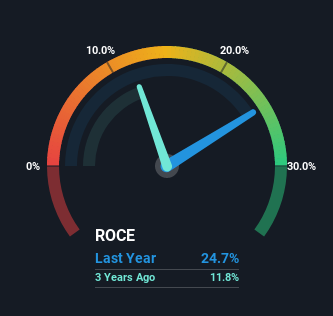
Did you know there are some financial metrics that can provide clues of a potential multi-bagger? In a perfect world, we'd like to see a company investing more capital into its business and ideally the returns earned from that capital are also increasing. Ultimately, this demonstrates that it's a business that is reinvesting profits at increasing rates of return. Speaking of which, we noticed some great changes in James Hardie Industries' (ASX:JHX) returns on capital, so let's have a look.
Return On Capital Employed (ROCE): What Is It?
If you haven't worked with ROCE before, it measures the 'return' (pre-tax profit) a company generates from capital employed in its business. The formula for this calculation on James Hardie Industries is:
Return on Capital Employed = Earnings Before Interest and Tax (EBIT) ÷ (Total Assets - Current Liabilities)
0.25 = US$855m ÷ (US$4.2b - US$687m) (Based on the trailing twelve months to September 2022).
So, James Hardie Industries has an ROCE of 25%. In absolute terms that's a great return and it's even better than the Basic Materials industry average of 5.5%.
Check out our latest analysis for James Hardie Industries

In the above chart we have measured James Hardie Industries' prior ROCE against its prior performance, but the future is arguably more important. If you'd like to see what analysts are forecasting going forward, you should check out our free report for James Hardie Industries.
What Does the ROCE Trend For James Hardie Industries Tell Us?
Investors would be pleased with what's happening at James Hardie Industries. Over the last five years, returns on capital employed have risen substantially to 25%. The company is effectively making more money per dollar of capital used, and it's worth noting that the amount of capital has increased too, by 103%. So we're very much inspired by what we're seeing at James Hardie Industries thanks to its ability to profitably reinvest capital.
What We Can Learn From James Hardie Industries' ROCE
A company that is growing its returns on capital and can consistently reinvest in itself is a highly sought after trait, and that's what James Hardie Industries has. Since the stock has returned a solid 51% to shareholders over the last five years, it's fair to say investors are beginning to recognize these changes. With that being said, we still think the promising fundamentals mean the company deserves some further due diligence.
On a final note, we've found 2 warning signs for James Hardie Industries that we think you should be aware of.
James Hardie Industries is not the only stock earning high returns. If you'd like to see more, check out our free list of companies earning high returns on equity with solid fundamentals.
New: Manage All Your Stock Portfolios in One Place
We've created the ultimate portfolio companion for stock investors, and it's free.
• Connect an unlimited number of Portfolios and see your total in one currency
• Be alerted to new Warning Signs or Risks via email or mobile
• Track the Fair Value of your stocks
Have feedback on this article? Concerned about the content? Get in touch with us directly. Alternatively, email editorial-team (at) simplywallst.com.
This article by Simply Wall St is general in nature. We provide commentary based on historical data and analyst forecasts only using an unbiased methodology and our articles are not intended to be financial advice. It does not constitute a recommendation to buy or sell any stock, and does not take account of your objectives, or your financial situation. We aim to bring you long-term focused analysis driven by fundamental data. Note that our analysis may not factor in the latest price-sensitive company announcements or qualitative material. Simply Wall St has no position in any stocks mentioned.
About ASX:JHX
James Hardie Industries
Engages in the manufacture and sale of fiber cement, fiber gypsum, and cement bonded building products for interior and exterior building construction applications primarily in the United States, Australia, Europe, New Zealand, and the Philippines.
Excellent balance sheet and good value.
Similar Companies
Market Insights
Community Narratives



